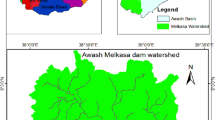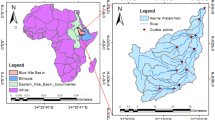Abstract
Sediment-Runoff process is highly variable and nonlinear in nature. In the present study an attempt has been made to develop a relationship between watershed stream length and Sediment Yield Index (SYI) and test it on Narmada watersheds, Madhya Pradesh, India. Area (A), Curve Number (CN) and stream length (SL) were utilized as input for model development. The three models (A model, CN model and simplified All India Soil and Land Use Survey (AISLUS) model including parameter SL) performed differently, with the coefficient of R2 equal to 0.01, 0.02 and 0.71 (Shakkar watershed), 0.11, 0.23 and 0.91 (Bamhani watershed), 0.06, 0.001 and 0.80 (Manot watershed) and 0.40, 0.05 and 0.66 (Mohgaon watershed), respectively. The logarithmic simplified AISLUS model incorporating parameter SL resulted with the coefficient of R2 as 0.76 (Shakkar watershed), 0.93 (Bamhani watershed), 0.84 (Manot watershed) and 0.66 (Mohgaon watershed). Therefore, the logarithm simplified AISLUS model was chosen as the best regression model for this study. It is observed that the simplified AISLUS model (logarithm form) incorporating parameter SL had a satisfactory efficiency as 76.35% (Shakkar watershed), 66.05% (Mohgaon watershed), 93.36% (Bamhani watershed), and 83.83% (Manot watershed) by Nash efficiency scale. The resulting higher Nash efficiency values support the versatility of the derived relationship and invoke assessment of SYI from the watershed stream length value. The prediction of SYI is important when adopting a suitable soil conservation measure in the watershed for minimizing soil erosion.








Similar content being viewed by others
References
AISLUS (1977) Priority delineation, Matatilla RVP, U.P Report No.Agri.484.
AISLUS (1991) Methodology of Priority Delineation Survey, All India Soil and Land Use Survey Technical Bulletin 9, Department of Agriculture and Cooperation, New Delhi, India
Brahim B, Meshram SG, Abdallah D, Larbi B, Drisss S, Khalid M, Khedher KM (2020) Mapping of soil sensitivity to water erosion by RUSLE Model: case of the inaouene watershed (Northeast Morocco). Arab J Geosci 13:1153. https://doi.org/10.1007/s12517-020-06079-y
Brath A, Castellarin A, Montanari A (2002) Assessing the effect of land-use changes on annual average gross erosion. Hydrol Eart Syst Sci 6:255–265
Caroni E, Singh VP, Ubertini L (1984) Rainfall-runoff-sediment yield relation by stochastic modelling. Hydrol Sci J 29(2):203–218
DahmardehGhaleno MR, Meshram SG, Alvandi E (2020) Pragmatic approach for prioritization of flood and sedimentation hazard potential of watersheds. Soft Comput. https://doi.org/10.1007/s00500-020-04899-4
Datta S (2016) Soil erosion, sediment yield and sedimentation of reservoir: a review. Model Earth Syst Environ 2:123
Delmas M, Olivier C, Jean-Marie M, Manuel G (2009) A method for developing a large-scale sediment yield index for European river basins. J Soils Sediments 9:613–626
Diodato N, Grauso S (2009) An improved correlation model for sediment delivery ratio assessment. Environ Earth Sci 59(1):223–231
Flaxman (1971) Sediment yield predictive equation, soil conservation service, Technical Service Centre Advisory–POI Washington D.C.U.S.D.A.
Gajbhiye S, Mishra SK, Pandey A (2013a) Effect of seasonal/monthly variation on runoff curve number for selected watersheds of Narmada basin. Int J Environ Sci 3(6):2019–2030
Gajbhiye S, Mishra SK, Pandey A (2013b) Estimation of design runoff curve numbers for Narmada watersheds (India). J Appl Water Eng Res 1(1):69–79
Gajbhiye S, Mishra SK, Pandey A (2013c) Prioritizing erosion-prone area through morphometric analysis: an RS and GIS perspective. Appl Water Sci 4(1):51–61
Gajbhiye S, Mishra SK, Pandey A (2014) Relationship between SCS-CN and sediment yield. Appl Water Sci 4(4):363–370
Gajbhiye S, Mishra SK, Pandey A (2015) Simplified sediment yield index model incorporating parameter CN. Arab J Geosci 8(4):1993–2004
Kasai M, Marutani T, Reid LM, Trustrum NA (2001) Estimation of temporally averaged sediment delivery ratio using aggredational terraces in headwater catchments of the Waipaoa River, North Island New Zealand. Earth Surf Process Landforms 26:1–16
Krasa J, Dostal T, Van Rompaey A, Vaska J, Vrana K (2005) Reservoirs’ siltation measurements and sediment transport assessment in the Czech Republic, the Vrchlice catchment study. CATENA 64:348–362
Lu H, Moran CJ, Prosser IP (2006) Modelling sediment delivery ratio over the Murray Darling Basin. Environ Modell Software 21:1297–1308
Meshram SG, Powar PL (2017) Piecewise regression using cubic spline-A case study. Int J Hybrid Inf Technol 10(1):75–84. https://doi.org/10.14257/ijhit.2017.10.1.07
Meshram SG, Powar PL, Singh VP (2017) Modelling soil erosion from a watershed using cubic splines. Arab J Geosci 10:155–168. https://doi.org/10.1007/s12517-017-2908-1
Meshram SG, Powar PL, Singh VP, Meshram C (2018a) Application of cubic spline in soil erosion modelling from Narmada Watersheds India. Arabian J Geosci 11:362
Meshram SG, Powar PL, Meshram C (2018b) Comparison of cubic, quadratic and quintic splines for soil erosion modelling. Appl Water Sci 8:173
Meshram SG, Ghorbani MA, Deo RC, Kashani MH, Meshram C, Karimi V (2019) New approach for sediment yield forecasting with a two-phase feedforward neuron network-particle swarm optimization model integrated with the gravitational search algorithm. Water Res Manag 33(7):2335–2356
Meshram SG, Singh VP, Kahya E, Alvandi E, Meshram C, Sharma SK (2020) The feasibility of multi-criteria decision making approach for prioritization of sensitive area at risk of water erosion. Water Res Manage. https://doi.org/10.1007/s11269-020-02681-7
Mishra SK, Singh VP (2003) Soil conservation service curve number (SCS-CN) methodology. Kluwer Academic Publishers, The Netherlands, pp 1–83 (ISBN 1-4020-1132-6)
Mishra SK, Singh VP (2003b) Derivation of SCS-CN parameter S from linear Fokker Planck equation. Acta Geophys Pol 51(2):180–202
Van Mullem JA (1989) Application of the green ampt infiltration model to watershed in Montana and Wyowing. MS thesis, Montana University, Bozeman, MT
Naqvi HR, Mohammed Abdul Athick AS, Ganaie HA, Siddiqui MA (2015) Soil erosion planning using sediment yield index method in the Nun Nadi watershed, India. Int Soil Water Conserv Res 3:86–96
Nbina JB (2012) Analysis of poor performance of senior secondary students in chemistry in Nigeria. Afr Res Rev Int Multidiscip J Ethiopia 6(4):324–334
Patel DP, Dholakia MB, Naresh N, Srivastava PK (2012) Water harvesting structure positioning by using geovisualization concept and prioritization of mini-watersheds through morphometric analysis in the lower Tapi Basin. J Indian Soc Remote Sens 40(2):299–312
Rao HSS, Mahabaleswara H (1990) Prediction of the rate of sedimentation of Tungabhadra Reservoir, Proc. Sym. On Erosion, Sedimentaion and Resource Conservation, Dehradun, India, 1:12-20
Sarma S, Saikia T (2012) Prioritization of sub-watersheds in Khanapara-Bornihat area of Assam Meghalaya (India) based on land use and slope analysis using remote sensing and GIS. J Indian Soc Remote Sens 40(3):435–446
Sharma SK, Gajbhiye S, Nema RK, Tignath S (2014) Assessing vulnerability to soil erosion of a watershed of tons River basin in Madhya Pradesh using remote sensing and GIS. Int J Environ Res Dev 4(2):153–164
Singh VP, Yadava RN (2003) Watershed management. Allied publisher private limited. ISBN 81-7764-545-5
Vanoni VA (1975) Sediment deposition engineering. ASCE Manuals and Reports on Engineering Practices, p 54
Wischmeier WH, Smith DD (1978) Predicting rainfall erosion losses. A guide to conservation planning. U. S. Dep. Agri., USDA handbook, No. 537, Washington D C
Yesuf HM, Assen M, Alamirew T, Melesse AM (2015) Modeling of sediment yield in Maybar gauged watershed using SWAT, northeast Ethiopia. CATENA 127:191–205
Zhou W, Wu B (2008) Assessment of soil erosion and sediment delivery ratio using remote sensing and GIS: a case study of upstream Chaobaihe River catchment North China. Int J Sediment Res 23:167–173
Zuo D, Xu Z, Yao W, Jin S, Xiao P, Ran D (2016) Assessing the effects of changes in land use and climate on runoff and sediment yields from a watershed in the Loess Plateau of China. Sci Total Environ 544:238–250
Acknowledgements
The authors thankfully acknowledge the Deanship of Scientific Research, King Khalid University, Abha, Kingdom of Saudi Arabia, for funding the research grant number RGP. 1/174/42.
Author information
Authors and Affiliations
Corresponding author
Ethics declarations
Conflict of interest
None.
Additional information
Publisher's Note
Springer Nature remains neutral with regard to jurisdictional claims in published maps and institutional affiliations.
Rights and permissions
About this article
Cite this article
Meshram, S.G., Singh, V.P., Meshram, C. et al. Simplified sediment yield index incorporating parameter stream length. Environ Earth Sci 80, 631 (2021). https://doi.org/10.1007/s12665-021-09919-6
Received:
Accepted:
Published:
DOI: https://doi.org/10.1007/s12665-021-09919-6




